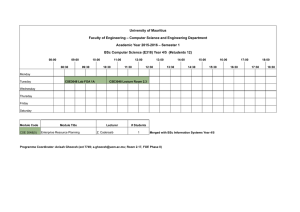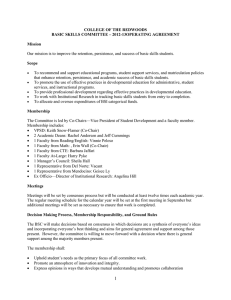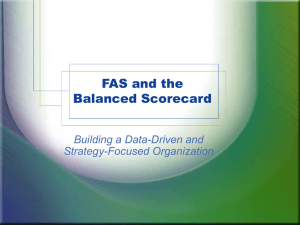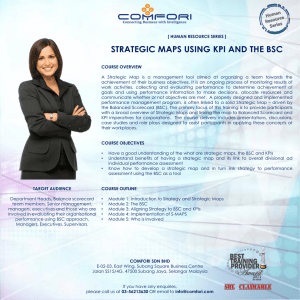Balanced Scorecard (BSC) BSC Basics: The balanced scorecard is
advertisement
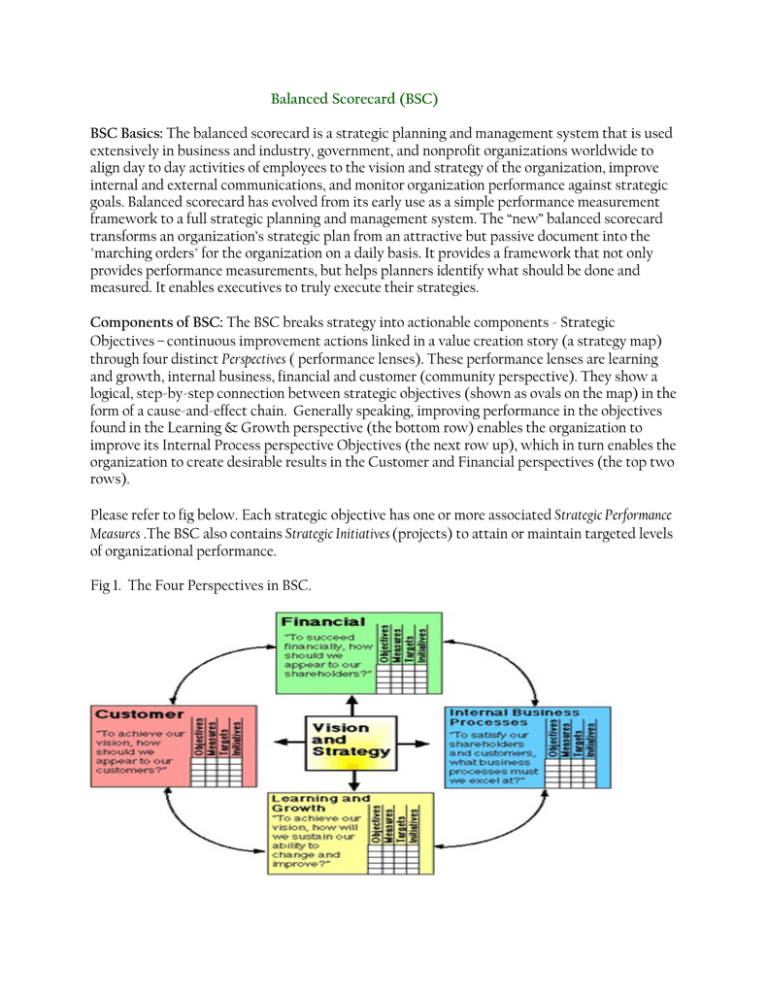
Balanced Scorecard (BSC) BSC Basics: The balanced scorecard is a strategic planning and management system that is used extensively in business and industry, government, and nonprofit organizations worldwide to align day to day activities of employees to the vision and strategy of the organization, improve internal and external communications, and monitor organization performance against strategic goals. Balanced scorecard has evolved from its early use as a simple performance measurement framework to a full strategic planning and management system. The “new” balanced scorecard transforms an organization’s strategic plan from an attractive but passive document into the "marching orders" for the organization on a daily basis. It provides a framework that not only provides performance measurements, but helps planners identify what should be done and measured. It enables executives to truly execute their strategies. Components of BSC: The BSC breaks strategy into actionable components - Strategic Objectives – continuous improvement actions linked in a value creation story (a strategy map) through four distinct Perspectives ( performance lenses). These performance lenses are learning and growth, internal business, financial and customer (community perspective). They show a logical, step-by-step connection between strategic objectives (shown as ovals on the map) in the form of a cause-and-effect chain. Generally speaking, improving performance in the objectives found in the Learning & Growth perspective (the bottom row) enables the organization to improve its Internal Process perspective Objectives (the next row up), which in turn enables the organization to create desirable results in the Customer and Financial perspectives (the top two rows). Please refer to fig below. Each strategic objective has one or more associated Strategic Performance Measures .The BSC also contains Strategic Initiatives (projects) to attain or maintain targeted levels of organizational performance. Fig 1. The Four Perspectives in BSC. In summary: BSC can help organizations in many ways: 1. 2. 3. 4. 5. Increase focus on strategy and results instead of tasks, Break down communication silos between departments Better understand and react to customer needs Improve organizational performance by measuring what matters Help leaders make better decisions based on leading performance indicators instead of lagging financial data 6. Help leaders budget time and resources more effectively 7. Help leaders and employees prioritize the work they do Balanced Scorecard (BSC) Implementation within the Health Sector in Ethiopia In cognizance of the importance of this tool, Hon. Minister Tedros applied the BSC approach as Director of the Tigray Regional Health Bureau. The Federal Ministry of Health (FMOH) was convinced that with adequate adaptation, the BSC approach could deliver significantly improved performance throughout the health system. In 2007 the FMOH became the first Ministry in the Government of Ethiopia (GoE) to apply the BSC approach, although it is the intent of the Ministry of Capacity Building that the BSC approach be used government-wide. In 2009, the FMOH, in Collaboration with the Ministerial Leadership Initiative for Global Health (MLI), selected the Balanced Scorecard Institute to improve strategic performance throughout the health system of Ethiopia The balanced scorecard approach will allow all participants in the system to understand how their performance contributes to the achievement of FMOH strategic objectives, and help align the Ministry vision with the work people do on a day-to-day basis. FMOH and MLI believe that the full implementation of the Balanced Scorecard will serve as an important tool for planning, monitoring and managing health sector development activities efficiently and effectively in Ethiopia. MLI and FMOH engaged the Balanced Scorecard Institute based upon the Institute’s experience in implementing the BSC framework within the public sector and based upon the FMOH’s successful pilot program which was built using the Institute’s Nine Steps to Success® public sector balanced scorecard framework. Some of Accomplishment to date: 1. The health sector strategic document (HSDP IV) developed based on BSC framework. 2. Health sector BSC developed using 3 leadership workshops (average participation of 20 leaders per workshop). See Figure 2 below. 3. BSCI provided three 2 week BSC Master Professional and two one week Mid level certification courses for a total of 125 staff from the health sector and the Ministry of Capacity Building. These trained professionals will be responsible for scaling up BSC implementation at different level of health sector and ministries across the GoE, respectively. 4. Health Sector BSC cascaded down to the FMOH, one of its directorates (Medical Service Directorate) and one specialized hospital under this directorate(St. Paul Specialized Hospital) using multiple BSC workshops and technical assistance. 5. BSC Health Sector and Cascading Manual developed – draft stage. Challenges 1. Other competing priorities within the FMOH in Ethiopia 2. Mainly seeing BSC as a monitoring and measurement tool for individual activities and implementation of Business-Process Reengineering (BPR). BPR is more focused on process improvement, whereas the BSC is more focused on improvement in all the four perspectives mentioned in Fig 1. Opportunities 1. Strong and engaged leadership mainly at Federal Level 2. BPR efforts well assimilated 3. Increasingly positive response to BSC Next Phase of BSC implementation 1. FMOH BSC cascaded to 3 directorates, including case team and individual levels within the directorates. 2. St. Paul BSC will be cascaded to directorate, case team and individual levels. 3. BSC will be developed for one regional health bureau, one regional hospital, one Woreda Health Office, one Kebele, and then further cascaded down to team and individual levels at the respective health structures. 4. Capacity building of one directorate (equivalent structure) to assume the role of Strategic Management Office at different levels of the sector in the following capacities: • Initiative planning and management capability • Performance measure development, tracking, analysis and refinement processes and procedures • Risk management identification and mitigation processes • Integration of quality systems management processes • BSC program evaluation and review Fig 2: Health Sector Strategic Map

